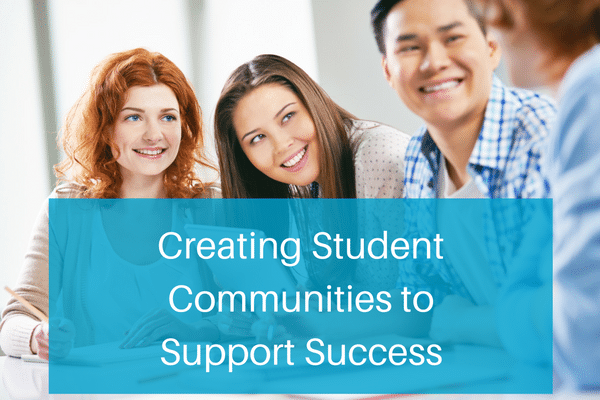Supporting and fostering first-year and transfer student success is constantly on the minds of institutions across the county. Student success has a huge impact on university and college rankings, as well as the educational environment and reputation as a whole. Additionally, many states are increasingly moving to higher education funding formulas that allocate a portion of funding based on performance indicators such as course completion, retention rates, or transfer rates.
Studies have shown that the establishment of learning communities is an effective way to support student success. In a recent article by Ellucian, Eric Moschella, the director of the Student Success Center at the University of South Carolina, noted that when it comes to successful students, “its all comes down to engagement. There is a great sense of community”.
Academic and social integration into campus life is a huge factor in first year students’ persistence. Communities that consist of students with common interests, whether that be students from the same major or students from a particular region, can help to establish a vital support network that is crucial to students in their first year. Positive peer relationships and community support developed from these student communities have proven to strengthen academic and social success among students, especially first-generation and/or underserved populations.
Student learning communities have been in the higher education realm for quite some time. Generally, the focus for many learning communities has been on establishing residence halls or first-year programs that are primarily aimed to support an educational path (for example, Engineering). While these education-focused communities may contribute to student success, a key component may be missing: the social aspect. The feeling of “not fitting in” can be a huge barrier to continuing on to the second year.
Incorporating new strategies and resources into student community programs is the key to sustainable communities that support student success, both academically and socially. That includes adapting programs to the needs and preferences of the incoming student generation, which technology plays a huge role in.
If you are looking to refresh your current student communities or start new communities for first-year students, we’ve outlined some strategies that will help you create meaningful communities that benefit students.
- Take advantage of technology.
The new incoming college generation is more than comfortable with technology. The idea of joining an online community may sound a lot more appealing than attending a BBQ or study session in the library. Online communication software like Slack is changing the way that both students and staff communicate with each other. Industries all over the world are creating Slack communities for topics and interests like Data Enthusiasts, Designers, and Web Programmers, and there’s no doubt that the younger generation is leading this trend. The Texas Executive MBA Class of 2016 at UT Austin sheds some light on how student communities can utilize online communication for more efficient collaboration and connecting.
How can you help facilitate Slack communities at your university? Consider creating a microsite dedicated to the Slack communities available for your students and instructions on how to create one. The Texas Executive MBA Class of 2016 at UT Austin gives a great example of how student communities can utilize online communication for more efficient collaboration and social connections.
- Utilize your most valuable resource: students.
Cornell’s freshman and transfer student program, Let’s Get Coffee, was founded by a team of sophomore students who recognized the importance of peer support for first year and transfer student success. The student-run program connects Upperclassmen with new students by assessing students’ extracurricular and career interests, majors, and what expectations students have of the program. They also partner with other programs on campus, increasing the ways new students can get involved.
- Incorporate aspects from inside and outside of classroom.
University of Richmond’s Living-Learning Programs combines classroom support with community trips to enhance the social aspect of the community. Its Women in Math and Science program not only places female students with an interest in math and/or science in dedicated residence halls, but it also offers multiple day trips throughout the year, guest speakers, and special dinners with faculty and staff.
- Build communities around extra-curricular interests, not just majors or fields of study.
Georgetown University offers communities that cater to students’ interests, like its Culture and Performance student community. Students, along with the faculty advisor, plan events and trips to theatre performances, foreign film and food nights, art gallery shows, and more. By tapping into students interests, not just their fields of study, students can gain a sense of inclusion which will ultimately help them succeed in their new environment.
- Promote groups that already exist.
Universities are full of motivated students that are looking to provide support for their fellow peers. Many students are looking to social networks, a resource that is native to today’s incoming student population, to connect with new students on campus and create a sense of community and inclusion.
Facebook’s tool, Groups for Schools, is a great way for students to search what types of online social communities already exist at their university. Students can search by college, including community and 4-year institutions, to discover groups that fall within their interest or areas of study. Many colleges offer groups like “ride shares” or “jobs and internships” that can be useful for students looking for resources on and off-campus. By providing a link to Groups for Schools in your online orientation, students can join ahead of time to ensure they get involved as soon as they arrive to campus.
Do you know a great example of a student community group that has been successful at your university? We’d love to hear about your programs. Email us at support@comevo.com with your tips, advice or examples of how you create and foster student communities for success. Comevo’s mission is to Cultivate technology to streamline and enhance the communication between organizations and their constituents.






